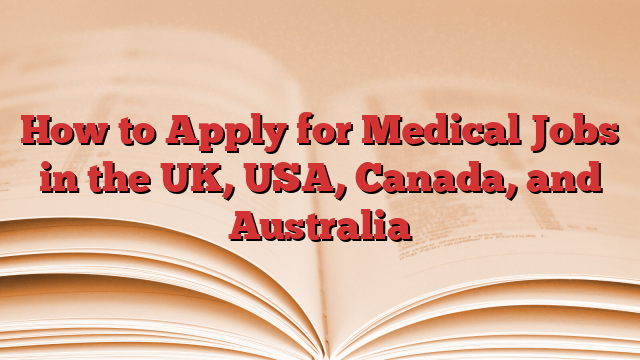
Are you a doctor dreaming of working abroad? Whether it’s better pay, career growth, or improved working conditions, countries like the UK, USA, Canada, and Australia offer fantastic opportunities for foreign-trained doctors.
But how do you apply? What exams do you need? What’s the visa process like?
This guide breaks down everything you need to know—from licensing exams to job applications and visa requirements. Let’s get started!
Step 1: Choose Your Destination & Understand the Process
Each country has different licensing exams, registration processes, and job application systems.
| Country | Licensing Exam | Regulatory Body | Job Platform |
|---|---|---|---|
| UK | PLAB | General Medical Council (GMC) | NHS Jobs, BMJ Careers |
| USA | USMLE | Educational Commission for Foreign Medical Graduates (ECFMG) | Health eCareers, NEJM Jobs |
| Canada | MCCQE | Medical Council of Canada (MCC) | Government Health Portals, Indeed |
| Australia | AMC Exams | Australian Health Practitioner Regulation Agency (AHPRA) | Seek, Health Workforce Australia |
Each country has a structured pathway for foreign doctors, and passing the licensing exams is the first step.
Step 2: Pass the Required Licensing Exams
United Kingdom – PLAB Route
To work as a doctor in the UK, you must pass the PLAB (Professional and Linguistic Assessments Board) exams.
✔️ Step 1: Pass PLAB 1 (Multiple-choice questions, can be taken in Ghana, Nigeria, etc.)
✔️ Step 2: Pass PLAB 2 (Practical exam in the UK)
✔️ Step 3: Register with the General Medical Council (GMC)
✔️ Step 4: Apply for jobs in the NHS via NHS Jobs
Key Tips:
- Aim for IELTS 7.5+ to meet English proficiency requirements.
- Once you pass PLAB 2, GMC registration is straightforward.
- Most international doctors start with FY2 or Trust Grade jobs in the NHS.
United States – USMLE Route
The United States Medical Licensing Examination (USMLE) is required for foreign-trained doctors.
✔️ Step 1: Pass USMLE Step 1 & Step 2 CK
✔️ Step 2: Get ECFMG certification
✔️ Step 3: Apply for Match (Residency Training) via NRMP
✔️ Step 4: Complete USMLE Step 3 after starting residency
Key Tips:
- USMLE is competitive, so aim for high scores (240+ on Step 1 & Step 2 CK)
- Apply through ERAS (Electronic Residency Application Service)
- Most foreign doctors enter through Residency Training (IMG-friendly programs)
Canada – MCCQE Route
To work as a doctor in Canada, you must pass the Medical Council of Canada Qualifying Exam (MCCQE).
✔️ Step 1: Pass MCCQE Part 1 (Can be taken worldwide)
✔️ Step 2: Pass NAC OSCE (Practical clinical exam)
✔️ Step 3: Get LMCC certification and apply for Practice-Ready Assessment (PRA) in provinces like Manitoba, Saskatchewan, etc.
✔️ Step 4: Apply for jobs through provincial health services
Key Tips:
- Canada prefers doctors with Residency or PRA experience
- Family Medicine & Rural Areas have more job opportunities
- French-speaking doctors have advantages in Quebec
Australia – AMC Route
To work as a doctor in Australia, follow the Australian Medical Council (AMC) pathway.
✔️ Step 1: Pass AMC Part 1 (Multiple-choice exam)
✔️ Step 2: Pass AMC Part 2 (Clinical exam) or enter Workplace-Based Assessment (WBA)
✔️ Step 3: Apply for AHPRA registration
✔️ Step 4: Secure a job via Health Workforce Australia
Key Tips:
- If you’re from the UK, Canada, or Ireland, you may qualify for Competent Authority Pathway (Easier Route)
- Australia has high demand for GPs, Emergency Medicine, and Rural Doctors
Step 3: Apply for Jobs & Visa Sponsorship
Once you’re licensed, the next step is job applications & visa sponsorship!
Where to Find Medical Jobs?
UK: NHS Jobs (www.jobs.nhs.uk), BMJ Careers
USA: NEJM Careers, Health eCareers
Canada: Provincial Health Portals, Government Job Websites
Australia: Seek, Health Workforce Australia
Visa Sponsorship Options
UK: Tier 2 (Health & Care Visa) – NHS employers sponsor visas
USA: J-1 Visa (for Residency), H-1B (for experienced doctors)
Canada: Express Entry (for permanent residency), Work Permit via provinces
Australia: 482 Visa (Employer-Sponsored) or Skilled Independent Visa
Pro Tip: Many hospitals and government health agencies offer visa sponsorship & relocation support.
Step 4: Relocate & Start Practicing! ✈️
Once you secure a job offer & visa, it’s time to relocate and begin your medical career abroad.
✔️ Prepare documents: Medical degree, transcripts, references, and police clearance
✔️ Find accommodation: Many hospitals provide temporary housing for new doctors
✔️ Understand the healthcare system: Each country has different medical record systems, prescribing rules, and hospital structures
✔️ Join medical communities: Networks like BMA (UK), AMA (USA), and RACP (Australia) can help you settle in
Final Thoughts – Should You Work Abroad?
Working as a doctor in the UK, USA, Canada, or Australia can be life-changing. You’ll gain:
✅ Higher salaries & better benefits
✅ Structured career progression & training
✅ A better work-life balance
But it’s not easy—exams, applications, and visas take time. Plan carefully, study hard, and stay persistent!
Are you a doctor planning to move abroad? Comment below with your biggest questions or experiences!
Found this helpful? Share it with fellow doctors!
